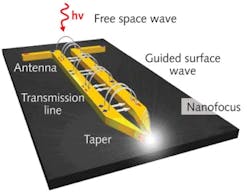NANOTECHNOLOGY/BIOSENSING: RF concept adapted to nanofocus IR light portends novel biosensors
An innovation designed to focus infrared (IR) light to nanometer dimensions may enable the development of ultra-miniature IR spectrometers, new lab-on-a-chip devices, and other types of chemical and biological sensors. The approach has important implications because it allows light to be transported over significant distances and nanofocused in a remote place.1
The novelty of the approach is found in its use of tapered transmission lines, an expansion on the concept of optical antennas, which enable the focusing of light to spot sizes below the diffraction limit (and thus boost single molecule spectroscopy, optical detector sensitivity, and so on).
Traditional optical antennae are bound to the focal points—a fact that limits flexibility in designing nano-optical circuits. But experiments conducted at CIC nanoGUNE Consolider, a cooperative research center in Spain (Donostia–San Sebastian), have demonstrated that infrared light can be transported and nanofocused using transmission lines made of two parallel nanowires.
The nanoGUNE researchers adapted to the IR range the concept of classic transmission lines, which are specialized cables made to carry radio frequency signals, for instance. Applied at MHz frequencies, where typical wavelengths are in the range of centimeters to several meters, the transmission line is a prime example for transporting energy in waveguides of strongly subwavelength-scale diameter. The researchers demonstrated that IR light can be transported in the same way, by scaling the transmission lines to less than 1 µm. They fabricated two metal nanowires and connected them to an infrared antenna, which captures the light and converts it into a propagating surface wave traveling along the transmission line. By gradually reducing the width of the transmission line, the researchers demonstrate that the IR surface wave is compressed to a tiny spot at the taper apex with a diameter of only 60 nm—or 150 times smaller than the free-space wavelength.
1. M. Schnell et al., Nature Photonics 5, 283–287 (2011).
About the Author

Barbara Gefvert
Editor-in-Chief, BioOptics World (2008-2020)
Barbara G. Gefvert has been a science and technology editor and writer since 1987, and served as editor in chief on multiple publications, including Sensors magazine for nearly a decade.
